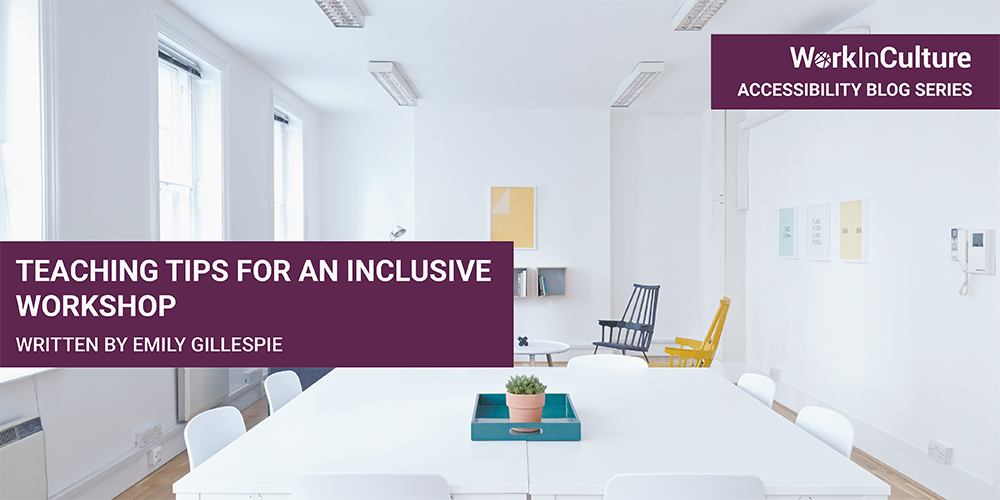
| Prioritizing Access (Volunteers) | Inclusive Workshops (Teaching Tips) | Support Providers | Leaders with Disabilities | Trauma-Informed Practices | Meaningful Outreach |
Written by Emily Gillespie
Introduction
Disabled people are not just consumers of the arts and culture, but also producers. Disabled people are often excluded from professional spaces, and it is essential that teaching and training spaces are inclusive. Community art organizations and hobby art classes are a vital part of community life.
Accessibility for workshops and classes goes beyond ensuring that buildings are accessible. Remember, many disabilities are not visible. A person’s ability to concentrate, pain levels, etc. may vary from week to week and shape participation. Creating inclusive classrooms does not mean that you need to know everything about a particular disability; rather, you are able to address varied needs as part of a continued individual and group conversation.
Accessibility should not be framed as an add-on, but rather the foundation of a workshop or classroom, and is also part of what makes a strong arts facilitator and collective group experience. The following ideas can be applied to a single workshop, or an ongoing class.
A Few Reminders and Ideas for Facilitators
- People are experts about their own needs and experiences.
- Accessible classroom layout and seating, room for mobility devices, seating near service providers, etc.
- Welcome support people and service animals.
- Consider starting a workshop with an access check-in where folks can state any needs they have that day. Also create space for people to check in with you one-on-one; don’t force folks to talk about their disability.
- Use content warnings for topics that may be emotionally tiring or triggering.
- Be aware that some people use technology and devices to accommodate their disabilities, such as computers and phones for note-taking.
- Commit to breaks and end times; solid end times are especially important for people using accessible transit.
- Be flexible with attendance and late entrances.
- Make no assumptions about participants pre-existing knowledge, don’t skip directions.
- Have information and directions in a variety of formats; for instance, can you re-word the instructions? Have written directions? Can you explain the directions to someone who isn’t aware of the terminology of the discipline?
- Are teaching materials accessible? For instance, does a video have accurate subtitles?
- Allow time for folks to speak and to think, don’t cut people off.
- Are there a variety of ways to participate in the group? For instance, can a written exercise be done verbally? Can a dance be done from a sitting position? This is often about being creative and checking in about needs.
Conclusion
Thinking about inclusive workshops and classrooms shapes, who has access to creative practices and artistic expression? Access should be imagined from a place of inclusion rather than framing accessibility needs as a checklist. How can the entire group work towards making a more accessible classroom? As a facilitator, it is helpful to reflect on, and challenge the pre-existing attitudes you have about disability.
How does inviting disability into the classroom expand the creative practice of the group and the ways that the art practice is conceptualized? How can classrooms be made accessible for disabled facilitators? Lastly, disabled people are often commended for showing-up in art spaces, how can you help them go beyond this and expand their art practice?
References:
Chandler, E. (2019). Introduction to cripping the arts in Canada. Canadian Journal of Disability Studies, 8 (1). http://cjds.uwaterloo.ca/index.php/cjds/article/view/468/709
Further Reading:
https://www.disabilityintersectionalitysummit.com/places-to-start
https://disabilityvisibilityproject.com/2019/02/01/access-is-love
http://www.hilaryinwood.ca/pdfs/resources/art%20education/inclusive%20art%20ed.pdf
###
More blogs from this series:
| Prioritizing Access (Volunteers) | Inclusive Workshops (Teaching Tips) | Support Providers | Leaders with Disabilities | Trauma-Informed Practices | Meaningful Outreach |
Emily Gillespie is a Toronto-based author and disability consultant, who enjoys using art to talk about disability. Emily recognizes that disabled people have different experiences and through her work focuses on people’s individual needs.
Follow Emily on Facebook and Twitter | Follow Accessibility Advocacy Art on Facebook
